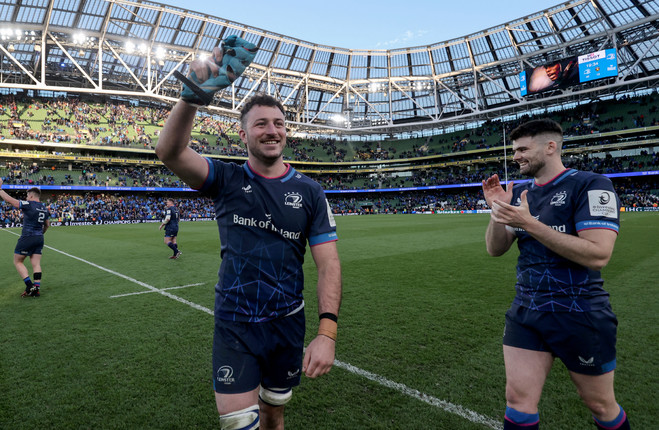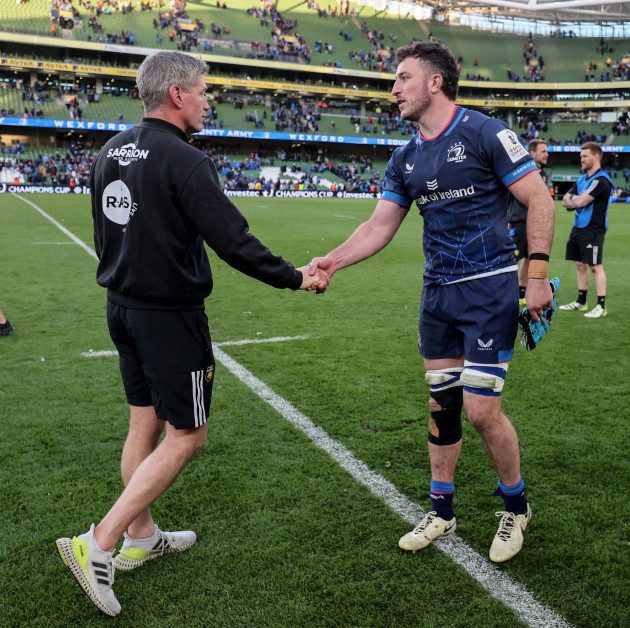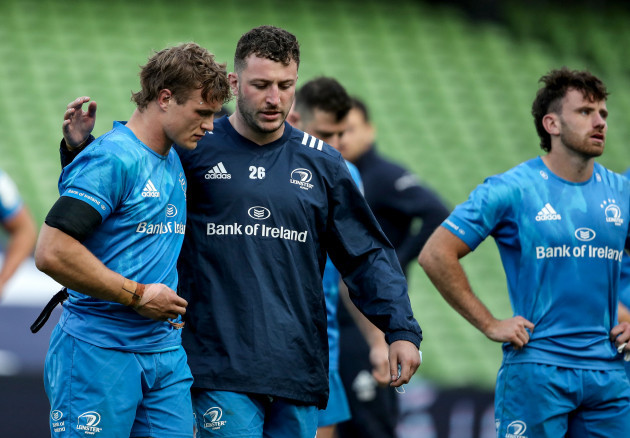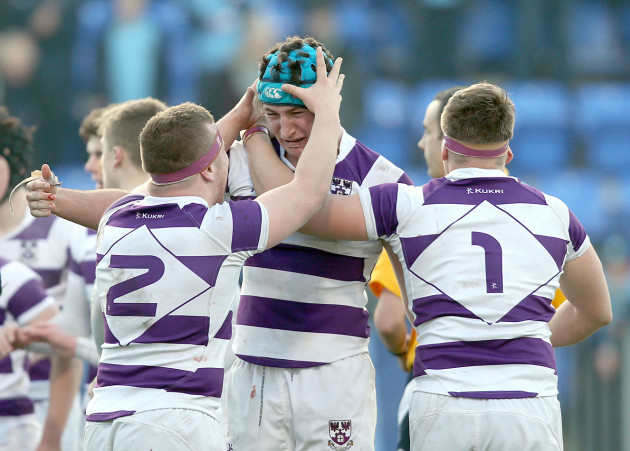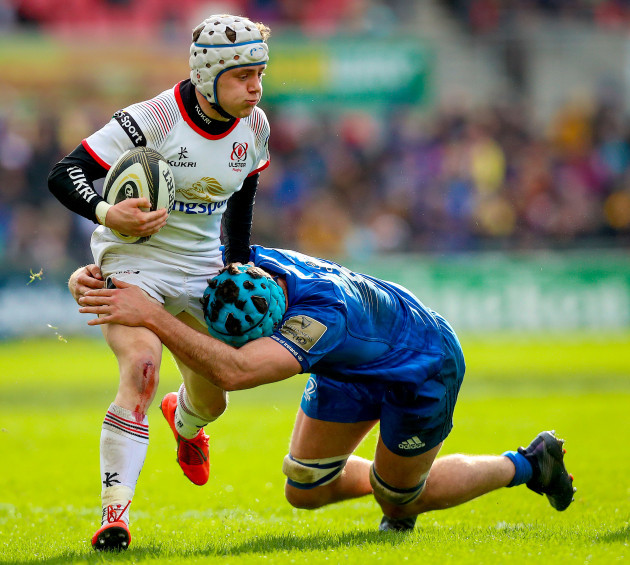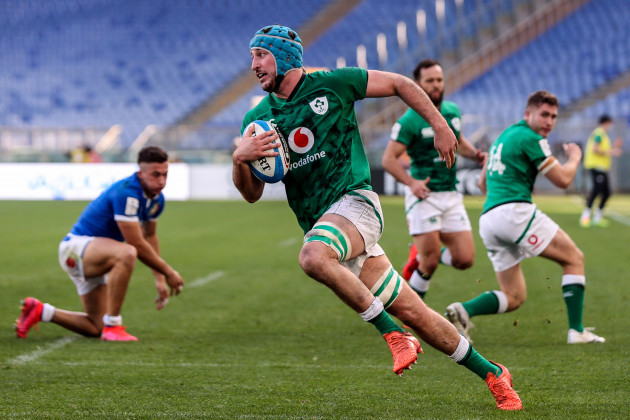IT’S REMARKABLE THAT for Will Connors, a 28-year-old who has played almost 50 times for Leinster and has nine test caps, the Champions Cup quarter-final thumping of La Rochelle was his first game in front of a full house at the Aviva Stadium.
Kildare man Connors had played six times previously at Lansdowne Road for both club and country. However, his Champions Cup debut against Saracens in September 2020 and his subsequent four home appearances for Ireland all took place during the most hellish part of the pandemic, behind closed doors. Connors’ family didn’t get a chance to watch him line out for his country in person.
There were 26,795 bums off their seats when Leinster hosted Munster in last year’s URC semi-final classic, which was Connors’ first taste of a ticketed game at the national stadium.
But there were almost twice as many bouncing bodies there for the La Rochelle clash just under a fortnight ago, virtually all of them wearing blue, as Leinster banished their demons from the ground at which they had suffered defeat in last year’s Champions Cup final, vanquishing the same opposition from the competition at the fourth knockout game of asking.
Connors collects plenty of rugby data for his PHD, which is focused on rugby’s tackle area and making the sport safer. He was naturally too busy last week sharpening his shoulders for the likes of Will Skelton to crunch the numbers from his past Aviva outings but, at a safe remove from the battle, they help him to join some dots.
“Well, now that I realise it was my first game at a sold-out Aviva, it makes sense that when I was walking out, the goosebumps were feckin’ popping out of me,” Connors laughs.
“I was just like, ‘Oh my God.’ It was almost like you could feel the atmosphere through your bones.
“Sometimes it’s that initial atmosphere, that’s where you feel it the most as a player. But even during the game, there was so much energy from the crowd. You do feel it.
I think that’s probably what took the team to another level against La Rochelle: we felt the presence of everyone there. Once you get that, it’s almost like your body just becomes a weapon and you’re literally going to do anything for your team and for the crowd.
“You go into something like a flow state, which is actually something I hadn’t properly experienced before. And again, that makes sense now that I realise… Well, I’d never actually played in front of a crowd like that before.”
La Rochelle had experienced first-hand Connors’ chop-tackling prowess in December’s narrow pool defeat at home to Leinster. In what was only his second ever Champions Cup appearance, Connors made 10 hits that day in just 49 minutes, neutralising several of the back-to-back European champions’ big ball-carriers.
Whether or not Ronan O’Gara and co. would have expected Leinster to unleash Connors from their holster for a third Champions Cup appearance in the quarter-finals is another matter.
It was Connors’ fellow openside, Josh van der Flier, who was put up for media duty on the Monday before the game, which would typically be an indication that he was due to start. Indeed, Van der Flier adorned the cover of the match programme on game day, which suggested that Leinster coaches Leo Cullen and Jacques Nienaber had initially intended to start the 2022 World Player of the Year only to swap him out for Connors at some point during the week.
But Connors — who equally found the matchday literature mildly curious — says Leinster’s plan never changed from Monday when he and Van der Flier were assigned their respective roles internally. He was given the week to prepare for his second successive Champions Cup start against La Rochelle, and replacement Van der Flier helped him up to speed.
“To be honest, we’re both very good mates,” Connor says of his fellow flanker. “We know we have different strengths and that’s why it tends to work so well when one of us takes the reins from each other.
“It’s a funny one because when we initially started to compete against each other, I was trying to get better at his key points of difference and he was trying to get better at mine. I’d pick his brain on his carries, his turnovers and stuff, and he’d pick my brain around the tackle and things like that.
But now, Josh and I have nearly started to drive each other in the other way. We’ve come to realise that we’re just two different players and we both add to the team differently. There’s no point in both of us trying to be the same so we push each other’s differences massively.
“We’ll have to see how things unfold for the rest of the season but using both of our differences worked for the two La Rochelle games, and it might work for that type of game again down the line.”
Connors laughs off the idea that he’s now seen as La Rochelle’s kryptonite but the data doesn’t lie: he’s 2-0 against the team that had inflicted three agonising defeats upon his teammates in recent years.
More pertinently, Leinster’s coaches plainly considered aspects of Connors’ game to be key to their chances of beating La Rochelle specifically, a reality only highlighted by the fact that the 28-year-old didn’t feature in any of Leinster’s four Champions Cup games between their pool and quarter-final meetings with ROG’s Rochelais.
“I suppose I’ve always tried to push the tackle as my own point of difference and against a big team like La Rochelle, I just try to take them down early, take the legs,” Connors says.
“Like, there isn’t really a huge amount of conversation that goes into it, to be honest. It’s literally the case that on the Monday, I was told I was starting and there’s not much more chat about it, then, between myself and the coaches.
It’s not like there’s this big masterplan behind it. It’s not, ‘Oh, we’re gonna shock La Rochelle and start Will in this game!’ It’s more, ‘Okay, Will, you’re starting this week.’ D’you know what I mean? And I’m just there, ‘Alright. Time to get my head in the game.’ And Josh and I will chat through it then.
Connors isn’t shy in admitting that the fixture took on an additional significance, however.
For one thing, the whole building felt different all week: this was, on paper at least, an epochal meeting between two European powerhouses, and a potentially definitive showdown in a rivalry from which La Rochelle had emerged with Champions Cup and Leinster only scars. That much was palpable among the squad.
For another, he found himself back in the laboratory working on a specific area of his game at which he might already be the best in the world: the chop tackle.
“For that kind of game, to get into the detail of it a little bit: I’d identified from the previous game that I’d been losing the ‘wrap’ in the tackle,” Connors explains.
“It’s just the final little bit where you get the clamp and you hold onto them. That gives you the lever, then, for that little bit of extra leg-drive which allows you to either push the carrier back or just keep them on the floor.
“I’d been losing that clamp on my left side in a few collisions, so it was just about working on a few more drills, practicing, to make sure it was right.
“Even if it was the case that a few of the previous tackles that I’d looked at had been unlucky, it was something I focused on all week: making sure that I could get a good shot in and then lock on, especially against the bigger bodies.
“That’s the kind of high-level detail that you’d have to identify and it did play a nice role in the game, thankfully.”
Connors made seven big hits in Leinster’s eventual 40-13 success, a couple of them especially memorable. He finished fourth in their tackle chart despite playing only 49 minutes before being replaced by his pal, Van der Flier.
A rugby player rarely becomes so synonymous with such a fundamental skill as Connors is with his famous chop. It’s rarer still that a player manages to do so while having paid proper attention to the skill only during their professional career.
When he played Leinster Schools Senior Cup for Clongowes, Connors wasn’t known for his tackling at all. It was for the most part his powerful ball-carrying and threat in the loose which opened doors for him to pursue a rugby career beyond school.
Only at U20 level did Connors’ tendency to chop-tackle begin to turn heads, particularly those of his Ireland coaches at the age grade.
“I remember maybe Nigel Carolan pointing it out and just being like, ‘Huh, that’s pretty effective,’” Connors says.
“Then, when I was in Leinster initially, I got injured for a long period of time. I started working a lot on tackle technique with Hugh Hogan — more so because I wasn’t able to do anything high-level, so I started doing some very low-level tackling drills: footwork into the tackle, wrap and clamp on a pad — really, really basic stuff.
“It felt really repetitive and… I dunno, kind of boring! But it was part of my rehab so I just kept tipping through it. ‘Grand.’
And then I came back playing and it just felt like it had become really easy to me. Suddenly, the tackle was a real strong point in my game. I just remember thinking, ‘It’s all so basic and yet it has such a huge impact on the outcome.’
“All of these little details that Hugh and I had worked on — late decision-making, making sure my head was on the right side — were coming together to add significantly to the bigger picture.
“From there, I just got more fascinated by it. I started doing more of it in my own time, trying to teach the lads around me. I was like, ‘Jeez, lads, Hugh Hogan’s cracked tackling! All you have to do is all of these little drills!’ And that is it.
“And that’s what I mean about working on it last week: if you drop off it, you do start to lose the skill. There are so many small bits to it that you have to keep ticking over.”
Connors, who has a degree in Computer Science from UCD, has since gone on to undertake a PhD with which he aims to make his sport safer by optimising tackle technique using tools such as computer vision and machine learning.
Think of VAR in soccer or the Hawk-Eye systems in the GAA or tennis, but apply that computer-vision technology to a pair of bodies crashing together on a rugby pitch: a computer being able to identify the positions of various body parts during a tackle, the speed of the tackle, the shared impact. And more.
Then, imagine having to train a computer programme to be able to do all of this in the first place when it was originally trained on road data from San Francisco.
Well, that’s Will Connors’ PhD.
“The basis of it was that the data-collection point in a lot of the research that’s done about rugby would be video analysis,” he says. “And that’s great: you can get a couple hundred tackles and have an expert look at them and ID whatever number of factors that are involved in the tackle.
“The other main point of data collection point in rugby is in a motion-capture lab. But the thing with that is you’re in a suit with a lot of little markers on you, you can only capture maybe 50 tackles — or more if you have a larger group of people — and it’s in that kind of lab environment which to an extent is unrealistic.
“The approach I’m trying to bring is what you’d call marker-less capture, where you’re trying to gain similar data to what you’d gain in a motion-capture lab — but you’re trying to do it using video data.
“It’s very difficult because rugby has so much of what we’d call ‘collision’ where somebody will get in the way, so you don’t have the perfect picture every time. But I’m in the process of trying to build that type of technology in the game.
“At the moment, I’m applying it to training data where you don’t have a big collision occurrence, you get that perfect picture initially. So, for example, you might use a tackle on a pad and then train the software to apply that to games.
“Essentially, it’s trying to take a computational approach to being able to capture rugby data — and with that data, if it’s fed back nicely to me, there are loads of exciting things you’d be able to do with machine-learning and IDing patterns from that.
“At the moment, I’m really enjoying it and getting good results. It’s just about trying to get the balance right between working on that and playing rugby myself!”
That balance will swing firmly towards the latter over the next six weeks — at least.
Leinster’s tour of South Africa concludes with a meeting with the Stormers in Cape Town this Saturday evening, after which their travelling party will reconvene back in Dublin with the frontliners who were kept home.
The mission will then shift towards a Champions Cup semi-final with Northampton Saints at a sold-out Croke Park on 4 May.
Connors, meanwhile, still hopes to have business down in the Rainbow Nation this summer, when Ireland darken the Springboks’ door for a two-game series on the world champions’ turf.
They’d be more hostile than the Aviva, but either Loftus Versfeld in Pretoria or King’s Park in Durban would make for a decent backdrop to a first test cap in front of a crowd…
“Ah, I’d love to get back involved,” Connors says of the Ireland setup. “When you’re out of it, you really do want to put everything towards getting back into it.
“The only way to do that, really, is playing in the big games for Leinster. If I can play those games and we start bringing silverware home, there, at least I’ll be in the shop window.
“I’ve unfortunately put myself out of contention over the years with a number of injuries and I think that’s probably the biggest killer. As they say, the best ability is availability.
“Thankfully, I’ve been available for the last while and if I can keep putting games together, I’d love to have another crack at it.”

